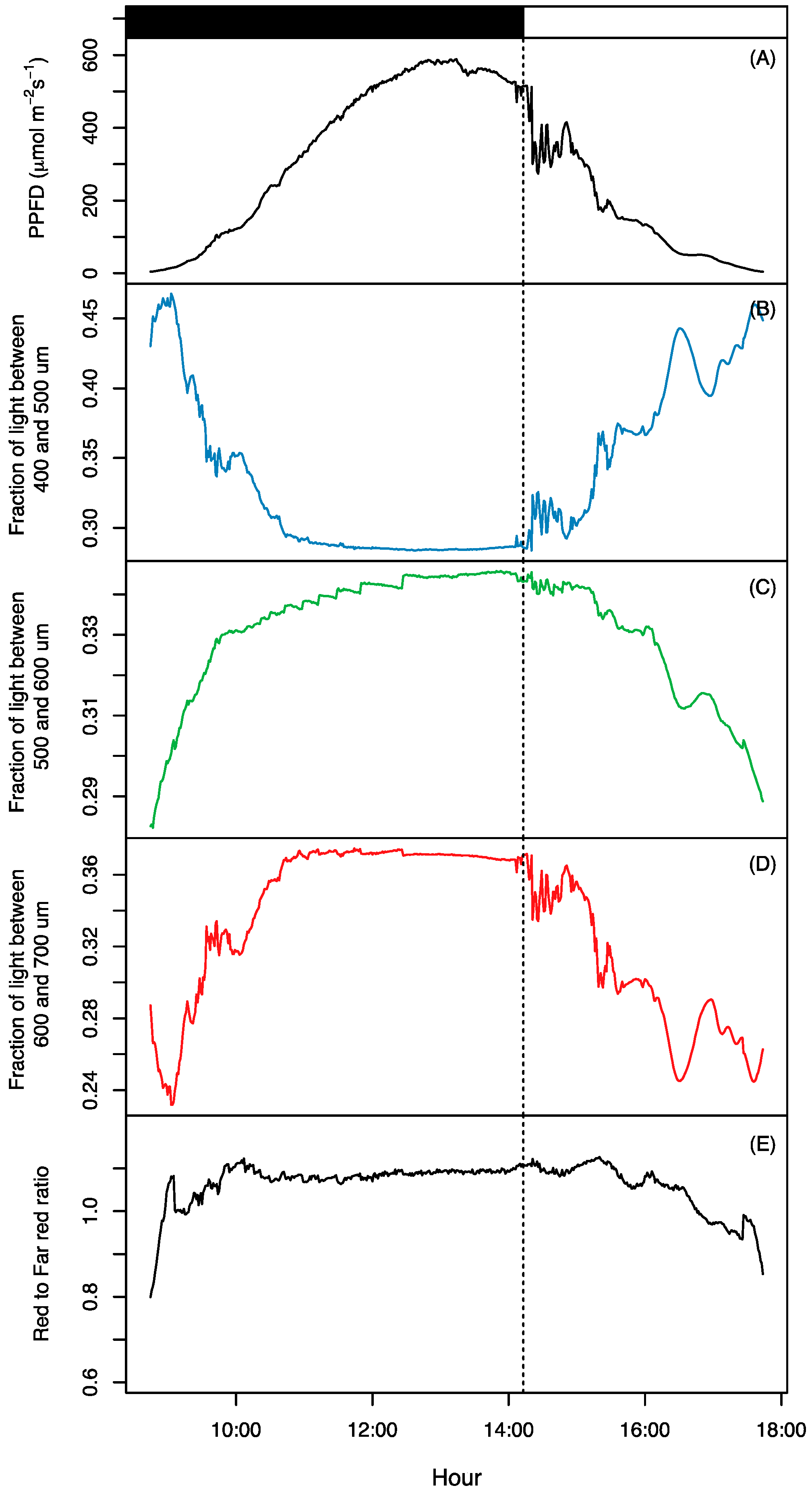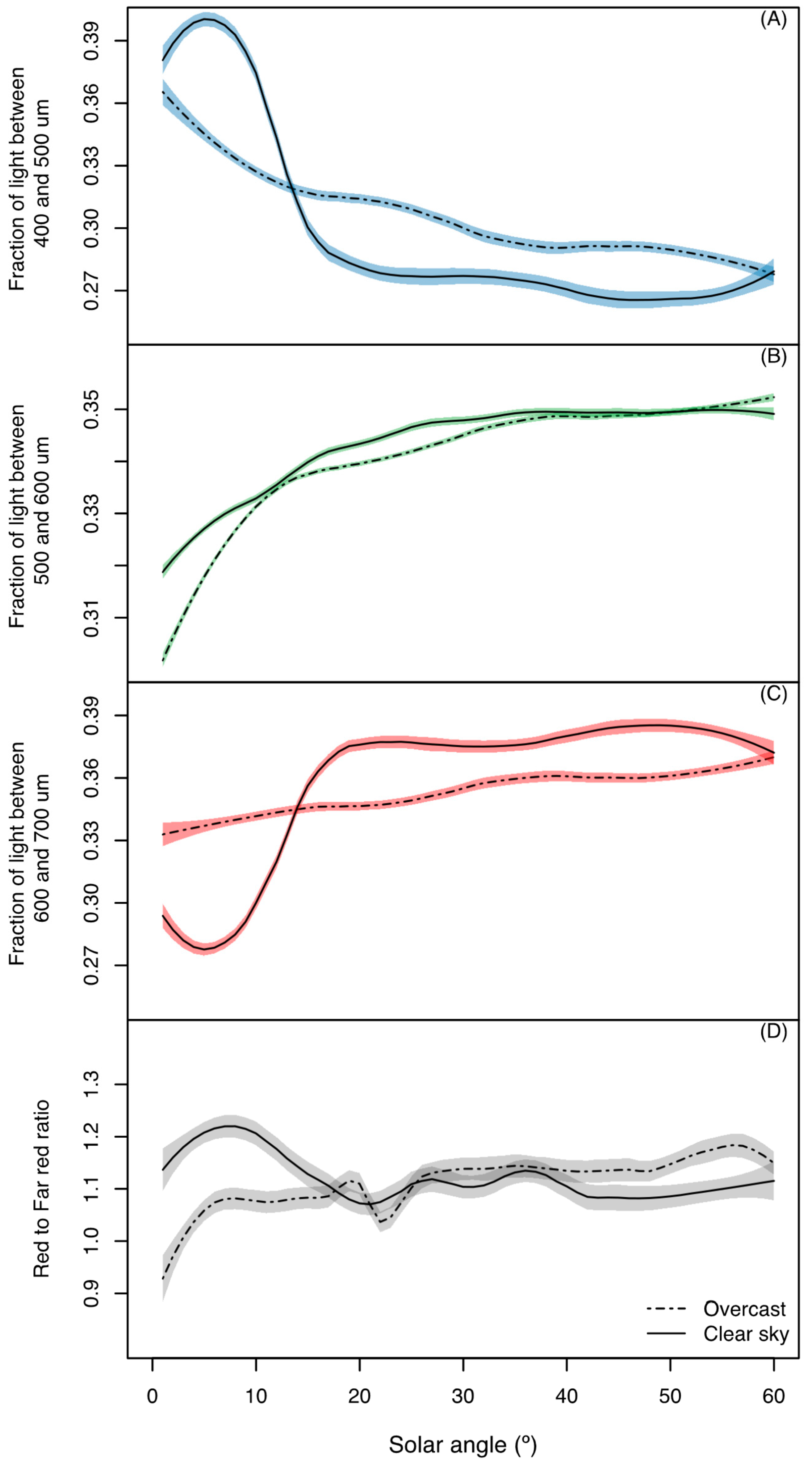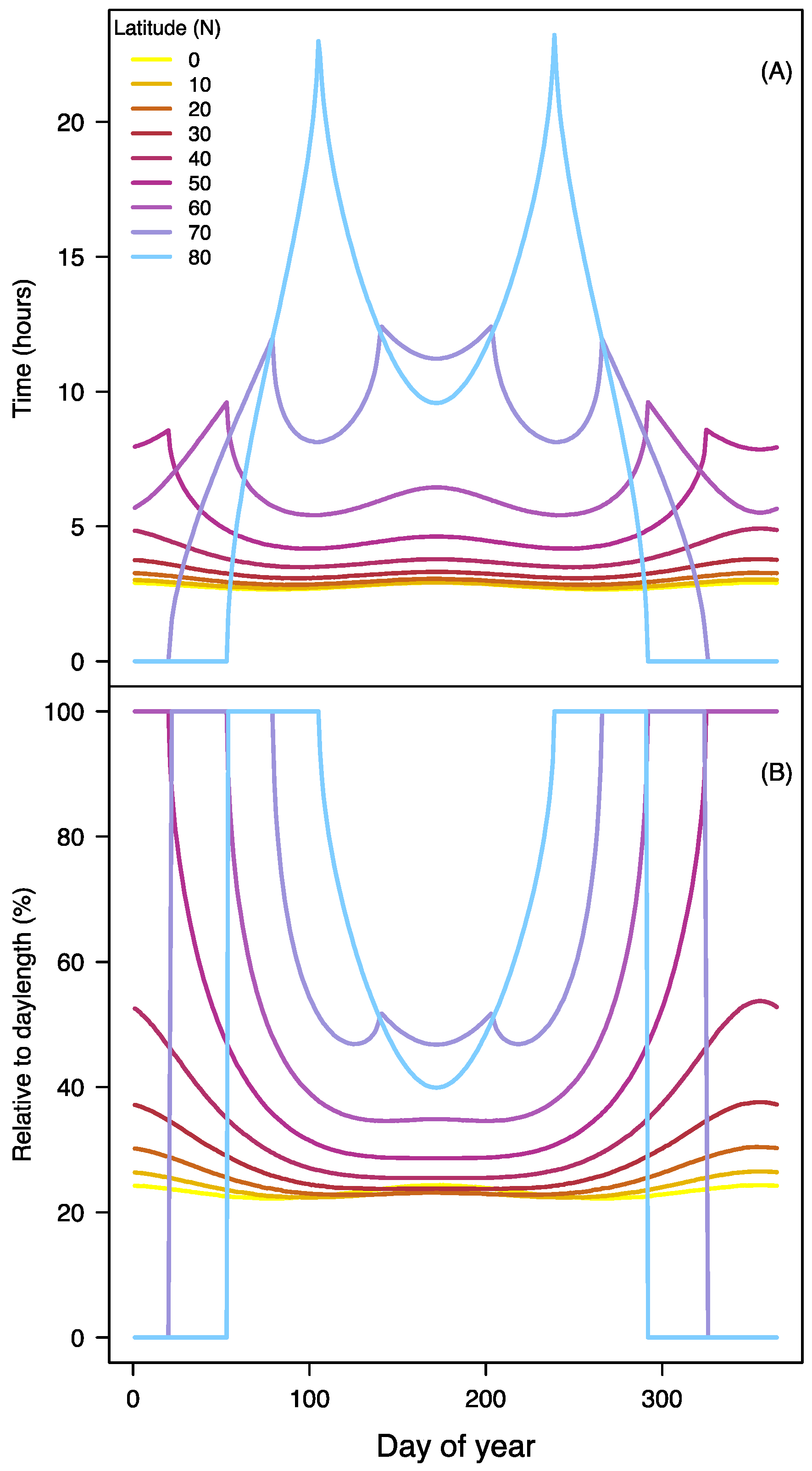Latitude and Weather Influences on Sun Light Quality and the Relationship to Tree Growth
Abstract
1. Introduction
2. Materials and Methods
2.1. Light Spectra Recordings
2.2. Light Energy Calculations
2.3. Light Quantity and Quality Proportions
2.4. Solar Elevation Angle Calculation
2.5. Literature Review
3. Results
3.1. Light Quality Changes Throughout the Day
3.2. Effect of Weather on Light Quality Changes at Low Solar Elevations Angles
3.3. Latitude Effects: Duration of Modified Light Quality and its Effect on Seedlings of Selected Tree Species
4. Discussion
5. Conclusions
Supplementary Materials
Author Contributions
Funding
Conflicts of Interest
References
- Smith, H. Light Quality, Photoperception, and Plant Strategy. Annu. Rev. Plant. Physiol. 1982, 33, 481–518. [Google Scholar] [CrossRef]
- Garner, W.; Allard, H. Further studies in photoperiodism, the response of the plant to relative length of day and night. J. Agric Res. 1923, 23, 871–920. [Google Scholar]
- Robertson, G.W. The Light Composition of Solar and Sky Spectra Available to Plants. Ecology 1966, 47, 640–643. [Google Scholar] [CrossRef]
- Jenkins, G. The UV-B Photoreceptor UVR8: From structure to physiology. Plant Cell 2014, 26, 21–37. [Google Scholar] [CrossRef]
- Hogewoning, S.; Trouwborst, G.; Maljaars, H.; Poorter, H.; Van Ieperen, W.; Harbinson, J. Blue light dose-responses of leaf photosynthesis, morphology, and chemical composition of Cucumis sativus growth under different combinations of red and blue light. J. Exp. Bot. 2010, 61, 3107–3117. [Google Scholar] [CrossRef]
- Terashima, I.; Fujita, T.; Inoue, T.; Chow, W.S.; Oguchi, R. Green Light Drives Leaf Photosynthesis More Efficiently than Red Light in Strong White Light: Revisiting the Enigmatic Question of Why Leaves are Green. Plant Cell Physiol. 2009, 50, 684–697. [Google Scholar] [CrossRef]
- Zhen, S.; Van Iersel, M.W. Far-red light is needed for efficient photochemistry and photosynthesis. J. Plant Physiol. 2017, 209, 115–122. [Google Scholar] [CrossRef]
- Overdieck, D. CO2-Gaswechsel und Transpiration von Sonnen-und Schattenblättern bei unterschiedlichen Strahlungsqualitäten. Ber. Dtsch. Bot. Ges. 1978, 91, 633–644. [Google Scholar]
- Furuyama, S.; Ishigami, Y.; Hikosaka, S.; Goto, E. Effects of Blue/Red Ratio and Light Intensity on Photomorphogenesis and Photosynthesis of Red Leaf Lettuce. Acta Hortic. 2014, 1037, 317–322. [Google Scholar] [CrossRef]
- Hernández, R.; Kubota, C. Physiological responses of cucumber seedlings under different blue and red photon flux ratios using LEDs. Environ. Exp. Bot. 2016, 121, 66–74. [Google Scholar] [CrossRef]
- Bula, R.; Morrow, R.; Tibbitts, T.; Barta, D.; Ignatius, R.; Martin, T. Light-emitting Diodes as a Radiation Source for Plants. Hortic. Sci. 1991, 26, 203–205. [Google Scholar] [CrossRef]
- Goldberg, B.; Klein, W. Variation in the spectral distribution of daylight at various geographical locations on the earth’s surface. SOL Energy 1977, 19, 3–13. [Google Scholar] [CrossRef]
- Clapham, D.H.; Dormling, I.; Ekberg, L.; Eriksson, G.; Qamaruddin, M.; Vince-Prue, D.; Vince-Prue, D. Latitudinal cline of requirement for far-red light for the photoperiodic control of budset and extension growth in Picea abies (Norway spruce). Physiol. Plant 1998, 102, 71–78. [Google Scholar] [CrossRef]
- Mølmann, J.; Asante, D.; Jensen, J.; Krane, M.; Junttila, O.; Olsen, J. Low night temperature and inhibition of gibberellin biosynthesis override phytochrome action, and induce bud set and cold acclimation, but not dormancy in hybrid aspen. Plant Cell Environ. 2006, 28, 1579–1588. [Google Scholar] [CrossRef]
- Opseth, L.; Holefors, A.; Rosnes, A.K.R.; Lee, Y.; Olsen, J.E. FTL2 expression preceding bud set corresponds with timing of bud set in Norway spruce under different light quality treatments. Environ. Exp. Bot. 2016, 121, 121–131. [Google Scholar] [CrossRef]
- Chiang, C.; Aas, O.T.; Jetmundsen, M.R.; Lee, Y.; Torre, S.; Fløistad, I.S.; Olsen, J.E. Day Extension with Far-Red Light Enhances Growth of Subalpine Fir. (Abies lasiocarpa (Hooker) Nuttall) Seedlings. Forests 2018, 9, 175. [Google Scholar] [CrossRef]
- Planck, M. On an improvement of Wien’s Equation for the spectrum. Ann. Phys. 1900, 1, 730. [Google Scholar]
- Sager, J.; Smith, W.; Edwards, J.; Cyr, K. Photosynthetic efficiency and phytochrome photoequlibria determination using spectral data. Trans. ASAE 1988, 31, 1882–1889. [Google Scholar] [CrossRef]
- NOAA. NOAA Solar calculator. 2018. Available online: https://www.esrl.noaa.gov/gmd/grad/solcalc/ (accessed on 15 May 2019).
- Aas, O. Effects of Light Quality and Temperature on Elongation Growth, Dormancy and Bud Burst in Norway Spruce (Picea abies) and Subalpine Fir (Abies lasiocarpa). Master’s Thesis, Norges Miljø- og Biovitenskapelige Universitet, Ås, Norway, 2015. [Google Scholar]
- Chiang, C. Interactive Effects of Light Quality and Temperature on Bud Set and Shoot Elongation in Norway spruce (Picea abies) and Subalpine fir (Abies lasiocarpa). Master’s Thesis, Norges Miljø- og Biovitenskapelige Universitet, Ås, Norway, 2016. [Google Scholar]
- Tsegay, B.A.; Lund, L.; Nilsen, J.; Olsen, J.E.; Molmann, J.M.; Ernsten, A.; Juntttila, O. Growth responses of Betula pendula ecotypes to red and far-red light. Electron. J. Biotechnol. 2005, 8. [Google Scholar] [CrossRef][Green Version]
- Clapham, D.H.; Ekberg, I.; Eriksson, G.; Norell, L.; Vince-Prue, D.; Vince-Prue, D. Requirement for far-red light to maintain secondary needle extension growth in northern but not southern populations of Pinus sylvestris (Scots pine). Physiol. Plant 2002, 114, 207–212. [Google Scholar] [CrossRef]
- R Core Team. R: A Language and Environment for Statistical Computing. Available online: https://www.R-project.org/ (accessed on 23 July 2019).
- Strutt, J.W. On the light from the sky, its polarization and color. Philos. Mag. 1871, 41, 107–120. [Google Scholar] [CrossRef]
- Spitschan, M.; Aguirre, G.K.; Brainard, D.H.; Sweeney, A.M. Variation of outdoor illumination as a function of solar elevation and light pollution. Sci. Rep. 2016, 6, 26756. [Google Scholar] [CrossRef]
- Zagury, F. The colors of the sky. ACS 2012, 2, 510–517. [Google Scholar] [CrossRef][Green Version]
- Ragni, M.; D’Alcala’, M.R. Light as an information carrier underwater. J. Plankton Res. 2004, 26, 433–443. [Google Scholar] [CrossRef]
- Yamada, A.; Tanigawa, T.; Suyama, T.; Matsuno, T.; Kunitake, T. Red: Far-red light ratio and far-red light integral promote or retard growth and flowering in Eustoma grandiflorum (Raf.) Shinn. Sci. Hortic. 2009, 120, 101–106. [Google Scholar] [CrossRef]
- Hughes, J.E.; Morgan, D.C.; Lambton, P.A.; Black, C.R.; Smith, H. Photoperiodic time signals during twilight. Plant Cell Environ. 1984, 7, 269–277. [Google Scholar]
- Morgan, D.C.; Smith, H. A systematic relationship between phytochrome-controlled development and species habitat, for plants grown in simulated natural radiation. Planta 1979, 145, 253–258. [Google Scholar] [CrossRef]
- Vince-Prue, D.; Clapham, D.; Ekberg, I.; Norell, L. Circadian timekeeping for the photoperiodic control of budset in Picea abies (Norway spruce) Seedlings. Biol. Rhytm. Res. 2001, 32, 479–487. [Google Scholar] [CrossRef]
- Tanino, K.K.; Kalcsits, L.; Silim, S.; Kendall, E.; Gray, G.R. Temperature-driven plasticity in growth cessation and dormancy development in deciduous woody plants: A working hypothesis suggesting how molecular and cellular function is affected by temperature during dormancy induction. Plant Mol. Biol. 2010, 73, 49–65. [Google Scholar] [CrossRef]
- Olsen, J.E. Light and temperature sensing and signaling in induction of bud dormancy in woody plants. Plant Mol. Biol. 2010, 73, 37–47. [Google Scholar] [CrossRef]
- Olsen, J.; Lee, Y. Trees and Boreal forests. In Temperature Adaptation in a Changing Climate: Nature at Risk; Storey, K., Tanino, K., Eds.; CABI: Wallingford, UK, 2012; Volume 3, pp. 160–178. [Google Scholar]




© 2019 by the authors. Licensee MDPI, Basel, Switzerland. This article is an open access article distributed under the terms and conditions of the Creative Commons Attribution (CC BY) license (http://creativecommons.org/licenses/by/4.0/).
Share and Cite
Chiang, C.; Olsen, J.E.; Basler, D.; Bånkestad, D.; Hoch, G. Latitude and Weather Influences on Sun Light Quality and the Relationship to Tree Growth. Forests 2019, 10, 610. https://doi.org/10.3390/f10080610
Chiang C, Olsen JE, Basler D, Bånkestad D, Hoch G. Latitude and Weather Influences on Sun Light Quality and the Relationship to Tree Growth. Forests. 2019; 10(8):610. https://doi.org/10.3390/f10080610
Chicago/Turabian StyleChiang, Camilo, Jorunn E. Olsen, David Basler, Daniel Bånkestad, and Günter Hoch. 2019. "Latitude and Weather Influences on Sun Light Quality and the Relationship to Tree Growth" Forests 10, no. 8: 610. https://doi.org/10.3390/f10080610
APA StyleChiang, C., Olsen, J. E., Basler, D., Bånkestad, D., & Hoch, G. (2019). Latitude and Weather Influences on Sun Light Quality and the Relationship to Tree Growth. Forests, 10(8), 610. https://doi.org/10.3390/f10080610





